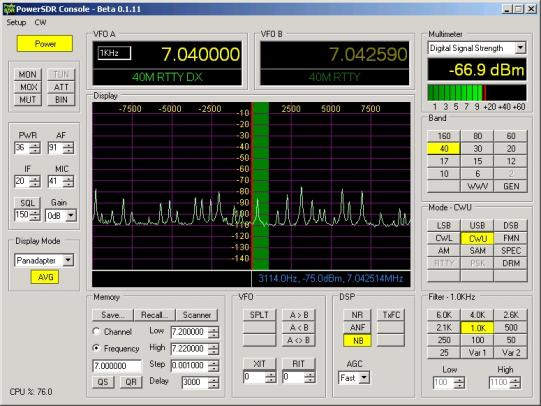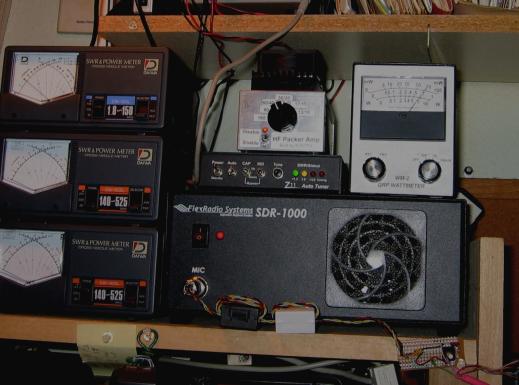KD5TFD Station: SDR-1000, Software Defined Radio
The radio I've been playing with most for the last few months is
an SDR-1000 from AC5OG's Flex-Radio
Systems. This radio is unlike any other on the amateur market, in
that it is software defined, the vast majority of the
demodulation and filtering is done by computer software instead of the
radio hardware.
Basically, the SDR-1000 hardware down converts a 40 khz swath of RF
and sends it to a PC sound card for filtering and demodulation. This
makes
for a very flexible high performance radio by putting most of the work
on a PC where it is easily changed.
This radio is ideal for someone that wants to experiment and learn
about software defined radio. The design is
well documented in "A Software Defined Radio For the Masses"
published in QEX and available here.
Additionally, the software side of the radio is licensed under the
GPL,
so it is totally open for experimentation. This has allowed lots
of smart people to enhance and modify the radio, and a community is
building around the radio.
My SDR-1000
 |
The screenshot to the left shows the PowerSDR console, the software
used with the SDR 1000. This particular screenshot shows about 20
hkz of spectrum during a CW contest on 40 meters. Each of the peaks
is a signal so clearly the band is crowded. The green area in the
spectrum is the portion of the spectrum that is being listened to.
This spectrum display is very useful to see what activity is
around. I work mostly digital modes (PSK, MFSK, Hellschreiber) etc.
and have started to recognize different modes by the shape of the
signal in the spectrum display.
|
Digital Modes on the SDR-1000
I'm very fond of the the digital modes (PSK, MFSK, etc) so have the
SDR-1000 setup to run digital modes. To do this I have a second
sound card in the computer that the digital mode program uses and
the inputs and outputs of that card are routed to the SDR-1000.
To get transmit audio from the digital mode program to the
SDR-1000 line out of the digital
mode sound card is routed to mic in on the SDR via an attenuator.

The attenuator is needed to match the line output to the mic input
on the SDR-1000 sound card. The capacitor is for DC blocking as
the mic input provides phantom power. None of the component values are
critical.
To get received audio from the SDR-1000 to the digital mode
program, the line out of the SDR-1000 sound card is split and sent to
the SDR 1000 hardware, as well as to line in of the SDR-1000. This
allows the speakers attached to the SDR-1000 to be muted and still
allow audio to go to the digital mode program to be decoded. The diagram below shows the
connections.

When running digital modes my computer screen looks like:

The screen shot above is from a SDR-SDR QSO I had with KC2LFI in
NY. In this QSO I had the SDR using a 70 Hz passband. The narrow
filters you can get with an SDR are terrific for PSK and CW.
The folks working on the PowerSDR software are working on
presenting a virtual sound card to the computer so that a second sound
card is not needed to run digital modes. One will simply be able to
tell MixW to use the SDR virtual sound card. Looking forward to that
work being done.
DRM with SDR-1000 and Dream
DRM stands for Digital Radio Mondiale and is an emerging standard
for digital shortwave broadcast transmissions. Using the SDR-1000 and
the open source Dream DRM
Receiver (binary availble here).

As can be seen from the spectrum above the DRM signal is about a 10
khz wide signal. The Dream program works by taking that signal at a
12khz IF and then demodulates and decodes that. This is a great
application for the SDR-1000 as it's trivial to produce the 12 khz IF
by simply changing the software. By comparison, to receive DRM using
my Kenwood TS-2000 will require a soldering iron!
The DRM audio sounds pretty good to me. Some samples:
Voice from Vatican Radio
Music from RNWB
These files are about 1 minute each of MP3 @ 32 kbps. To my ear
they are a good reproduction of the audio quality received by Dream.
Mods I've done to my SDR-1000
VK6APH's QSD T/R swith mod using FSD3126 bus switch
Future plans, other SDR things to explore
I've got a 100 watt amplifier to install into the SDR-1000. This
will replace the HF Packer amp. I'll miss using the HF Packer,
there's
something magic about getting RF out of something built with your own
hands! Maybe I'll build a K2 to put the HF Packer to good use!
I've also stared playing with GNU
Radio and Linrad
with the SDR 1000 as well as some other hardware such as the Simple Software
Radio Peripheral
(SSRP). Very exciting to see all the various software defined
radio projects going on.
Comments to: Bill Tracey (kd5tfd@ewjt.com)
Last Updated: 8 March 2005
Copyright © Bill Tracey 2005






